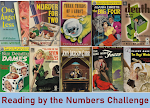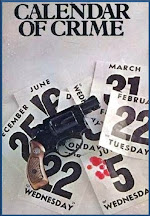
If you read the back of the book, you would suspect that The Red Lamp by Mary Roberts Rinehart is a bit gothic in nature. Perhaps a young woman in danger or Had-I-But-Known book. See for yourself:
Jane wanted to leave Twin Towers the moment she arrived. She had a strange feeling about the old mansion, a chilling apprehension of doom that followed her through the creaking halls like a death shadow. The others thought her fears were groundless--until they felt the evil iridescence of the Red Lamp, and realized how terrifyingly right she was.
But then you read the book and you find out this isn't a woman-in-danger book. The story isn't really about Jane at all. It's a man in danger. And, as a matter of fact, it's a Professor in danger. Which anyone who knows me would think would immediately make my interest in the book go up dramatically. It did. For about twenty pages. Maybe. The trouble is Professor William Porter does so much of the damage himself. As the detective Greenough tells him, "you'll have to admit that you've seemed to go out of your way all summer to get into trouble!" So, what is the trouble, you ask?
Well...Professor William Porter has inherited Twin Towers from his Uncle Horace. Uncle Horace died from what was declared natural causes--a simple heart attack. Or was it? Was he literally scared to death by earthly agents or...perhaps by supernatural forces? Twin Towers had been rumored to be haunted. There are tales of a red lamp that glows in its windows at night. And when the red lamp glows, things happen. Things that no one can explain.
Jane is Professor Porter's wife. She comes into the story only peripherally. Jane, it seems, has a bit of the mediumistic quality about her. She had a "vision" the night Uncle Horace died and warned Porter that she had seen his uncle dead on the library floor of Twin Towers--before the phone call came confirming her premonition. Throughout the book, she has these little moments of supernatural vision...just enough to give the story a shove when it's lagging a bit. As the blurb mentions, when the idea of going to Twin Towers for their summer holiday is broached, Jane doesn't want to go. She won't give a solid reason...but she refuses to stay in the house. So she and Porter along with their niece Edith and her beau go to the grounds of Twin Towers, but stay in the Lodge (Jane, Porter & Edith) and Halliday (the beau) in the boathouse.
It is decided that they will rent the main house out and they do so--to an elderly, infirm gentleman and his secretary. In the meantime, a madman seems to be on the loose. First sheep are killed--their throats expertly cut--and then a young deputy is killed and a young woman disappears. The locals seem to believe that the red lamp has called up some kind of demon that is terrorizing the countryside. Greenough is brought in to get to the bottom of things and Porter becomes convinced that he is the main suspect. He then sets out to do just about every suspicious thing he can in order to ensure that he is the main suspect. He begins to think that everyone (bar his little entourage) is against him and he and Halliday start detecting on their own in an attempt to find the real culprit. It all comes together in a spooky grand finale in the haunted house--complete with seance and red lamp.
This is the Mary Robert Rinehart story that tried to be supernatural and failed. It never did get the right creepy-crawly atmosphere. And I didn't really sympathize with poor, persecuted Professor Porter. I just wanted him to sit still for a few moments and let some things happen when he had a roomful of witnesses so he could be sure that nobody suspected him. After all, if you don't want your neighbors to think you're the sheep-killer, then don't go skulking around countryside at night. It really shouldn't take a PhD to think that one out (and it didn't...).
I also had difficulty with the journal entry style of writing. There are times when this works, but this isn't one of them. Porter's journal entries seem to ramble and there were many instances where I had to thumb back a couple of pages and sort myself out. It made it difficult to settle down to the story.
What saves this book is Rinehart. Even when the style isn't quite right; even when the supernatural setting doesn't quite come off--she can still write and there are some mighty good portions that help keep The Red Lamp from being a total loss. If I can find some choice quotes (as you can see below I did), then a book can't be all bad. I enjoyed the characters of Edith and Halliday very much. I think perhaps if this had been written with more of a focus on them--with straightforward story-telling rather than the journal entries--then we might have had a much better book. Two and a half stars.
Quotes:
...a man may shout the eternal virtues and be unheard forever, but if he babble nonsense in a wilderness it will travel around the world. (p. 41)
It is only in his head that man is heroic; in the pit of his stomach he is always a coward. (p. 43)
In the pursuit of English literature the wear and tear is on the trouser seats rather than the muscles....I could no more strangle a man than I could bulldog a steer. (p. 93)
"There is no such thing as a perfect crime," he [Halliday] said, "and of course the general idea that clue is some mysterious phenomenon which it requires superhuman powers to understand, is all bosh. Clues are practically always trivial, because it is only the trivial things the criminal overlooks. He takes care of the big ones." (p. 119)
It is characteristic of the average mind often to question what it hears but to believe wholeheartedly what it reads. (p. 151)
"Well, professor," he [Greenough] said, "it's a darned queer world, there's no denying it."
"The world's all right. It's the people in it who mess things up." [Willaim Porter] (p. 224)






























6 comments:
Rinehart is one of those authors that I read with some enthusiasm when I first got into mysteries in my teens, but I found my enthusiasm was quickly overtaken by the likes of Queen and Christie first and then the hardboiled school of Chandler, Hammett and Macdonald later on. I never quite got back to reading her work, which i regret slightly since, I suspect, I got a bit sniffy as my tastes changed. I think I found the style old-fashioned, for want of a better word, thought hat didn't stop me loving Doyle and Wilkie Collins, so it's not just the distance in years, but in attitude I suppose. You've really made me want to go back and see exactly which of her books I've got on the shelf (probably all in Italian translations ...) and see what I might feel about her work now.
This book gets so many different reactions, but I think if I ever finally read it (I do have a copy that I found last year) I think I would have very much the same reaction as you do. Great quotes, BTW!
I keep wanting to read THE MAN IN LOWER TEN because of the spectacular train wreck so beautifully illustrated in the copy I own. (Hmm...can a train wreck be beautiful? Well, the pictures make it seem so.) I've always wondered how Rinehart would handle a "disaster" scene that it right out of The Fugitive.
I'll stay away from this one, Bev. For sure. I think I've pretty much read all the best MRR books this past year.
When she was good, she was great. But when she wasn't she wasn't.
Know what I mean?
@Sergio & Yvette: Yes, Rinehart has some very good ones (I've enjoyed all the others I've read so far). I'm hoping that there are more good ones to come--I've got quite a few on the TBR stack that I picked up at last year's Red Cross Book Sale.
@John: The Man in Lower Ten is on the docket for my Murder by the Numbers Vintage Theme.
I have been meaning to read a Rinehart but I may skip this one. Great review though - very detailed.
I haven't read this one yet, but have a feeling that I'm so taken with her right now that i'll be able to gloss over the not so great parts.
Post a Comment